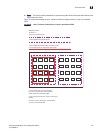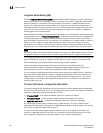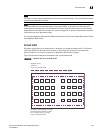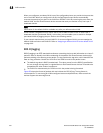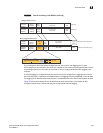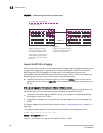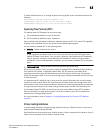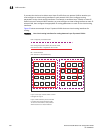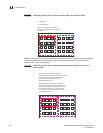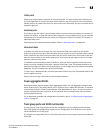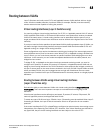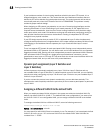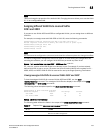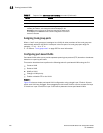
PowerConnect B-Series FCX Configuration Guide 439
53-1002266-01
VLAN overview
13
VLAN and virtual routing interface groups
Dell PowerConnect devices support the configuration of VLAN groups. To simplify configuration,
you can configure VLAN groups and virtual routing interface groups. When you create a VLAN group,
the VLAN parameters you configure for the group apply to all the VLANs within the group.
Additionally, you can easily associate the same IP subnet interface with all the VLANs in a group by
configuring a virtual routing interface group with the same ID as the VLAN group.
For configuration information, refer to “Configuring VLAN groups and virtual routing interface
groups” on page 472.
Dynamic, static, and excluded port membership
When you add ports to a protocol VLAN, IP subnet VLAN, IPX network VLAN, or AppleTalk cable
VLAN, you can add them dynamically or statically:
• Dynamic ports
• Static ports
You also can explicitly exclude ports.
Dynamic ports
Dynamic ports are added to a VLAN when you create the VLAN. However, if a dynamically added
port does not receive any traffic for the VLAN protocol within ten minutes, the port is removed from
the VLAN. However, the port remains a candidate for port membership. Thus, if the port receives
traffic for the VLAN protocol, the device adds the port back to the VLAN.
After the port is added back to the VLAN, the port can remain an active member of the VLAN up to
20 minutes without receiving traffic for the VLAN protocol. If the port ages out, it remains a
candidate for VLAN membership and is added back to the VLAN when the VLAN receives protocol
traffic. At this point, the port can remain in the VLAN up to 20 minutes without receiving traffic for
the VLAN protocol, and so on.
Unless you explicitly add a port statically or exclude a port, the port is a dynamic port and thus can
be an active member of the VLAN, depending on the traffic it receives.
NOTE
You cannot configure dynamic ports in an AppleTalk cable VLAN. The ports in an AppleTalk cable
VLAN must be static. However, ports in an AppleTalk protocol VLAN can be dynamic or static.
Figure 92 shows an example of a VLAN with dynamic ports. Dynamic ports not only join and leave
the VLAN according to traffic, but also allow some broadcast packets of the specific protocol to
“leak” through the VLAN. Refer to “Broadcast leaks” on page 441.



